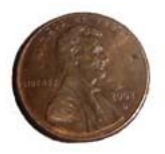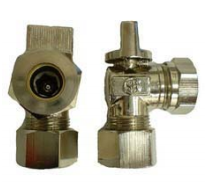Copper
View/Download PDF Version
Copper
Copper is a reddish-brown metallic element that is considered an essential nutrient in the human diet. It is also commonly used in brass, coins, pipes, and electrical wiring. Copper is rarely found in high concentrations in groundwater, but can find it’s way into drinking water through corrosion of pipes. The degree to which copper plumbing will corrode and introduce copper into drinking water depends on the corrosivity of the water. Corrosive water generally has a low pH but other factors such as temperature and conductivity also play in.
 Copper in Drinking Water
Copper in Drinking Water
Copper is generally detectable by metallic taste at concentrations of 1 to 2 mg/L and makes water undrinkable at concentrations of 5 to 8 mg/L. Copper can also cause blue-green staining on sinks and fixtures. If a water supply is corrosive, new copper piping is likely to corrode and dissolve copper into the water. Under these corrosive conditions the copper concentration increases as the water sits in contact with the pipes. This means that the first draw from the tap after water has been sitting in the pipes has a higher copper concentration than water that simply moves quickly through the pipe system. For this reason, if you suspect corrosion of copper plumbing, it is a good idea to have a water sample tested that is taken immediately after turning the tap on after leaving the tap off for 12 hours.
Health Effects from Copper
The US Environmental Protection Agency has set 1.3 mg/L as a drinking water standard for copper. This standard only regulates public water systems, but the health implications are relevant for private well owners. High concentrations of copper can cause vomiting, diarrhea, stomach cramps and nausea. Copper has also been shown to cause liver and kidney damage. Children under one year of age and people with Wilson’s disease are particularly vulnerable to the toxic effects of copper.
Treating for Copper
Hot water will leach more copper from plumbing than cold water, therefore avoid using water from the hot water tap for cooking or drinking. Flush the cold water line by running water through the lines for a few minutes before collecting drinking water. You can collect the flushed cold water to rinse dishes or water plants and then fill jugs for drinking water that can be stored in the fridge.
Alternative choices include:
- Replacement of copper plumbing with CPVC or other alternative materials that meet local code
- Water treatment with a neutralizing tank filter or caustic liquid treatment to reduce corrosivity of water
- Removal of copper by installing an adsorption (i.e. carbon or charcoal), reverse osmosis, or distillation system at the drinking water tap
Additional Resources
Click on the links below to be directed to more resources.
World Health Organization Fact Sheet
NSF International Home Water Treatment Devices
